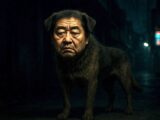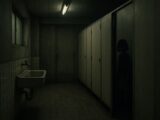10 Terrifying Japanese Urban Legends That Will Chill You to the Bone
10 Terrifying Japanese Urban Legends That Will Chill You to the Bone
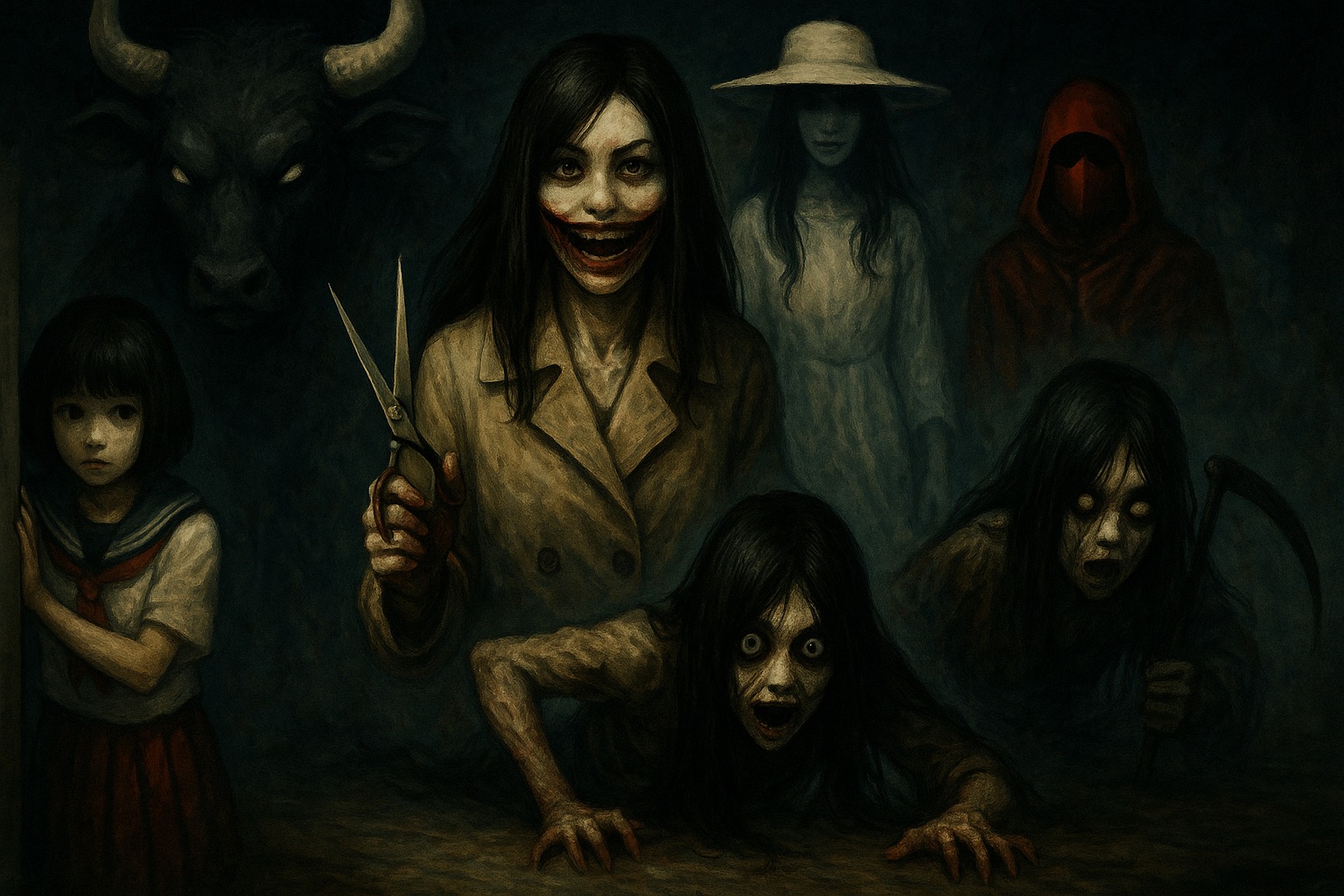
There are stories that cling to the dark corners of the world, whispered from one generation to the next. In Japan, a country with a rich history of folklore filled with yokai (spirits) and yurei (ghosts), these tales have evolved into something far more intimate and terrifying: Japanese urban legends. These are not ancient myths confined to dusty scrolls; they are modern nightmares that blur the line between reality and the supernatural, making you question the safety of a lonely street, a public restroom, or even the screen you’re reading this on.
This is not a list for the faint of heart. We will delve into the 10 most bone-chilling Japanese urban legends that have captivated horror fans across the globe. From vengeful ghosts born of tragedy to digital curses that claim real-world victims, these tales are crafted to leave a lasting, icy dread.
They’re just stories, of course. But as you read on, a single, terrifying question will linger: What if they’re real?
Reader discretion is advised.
10. Gozu (Cow Head)
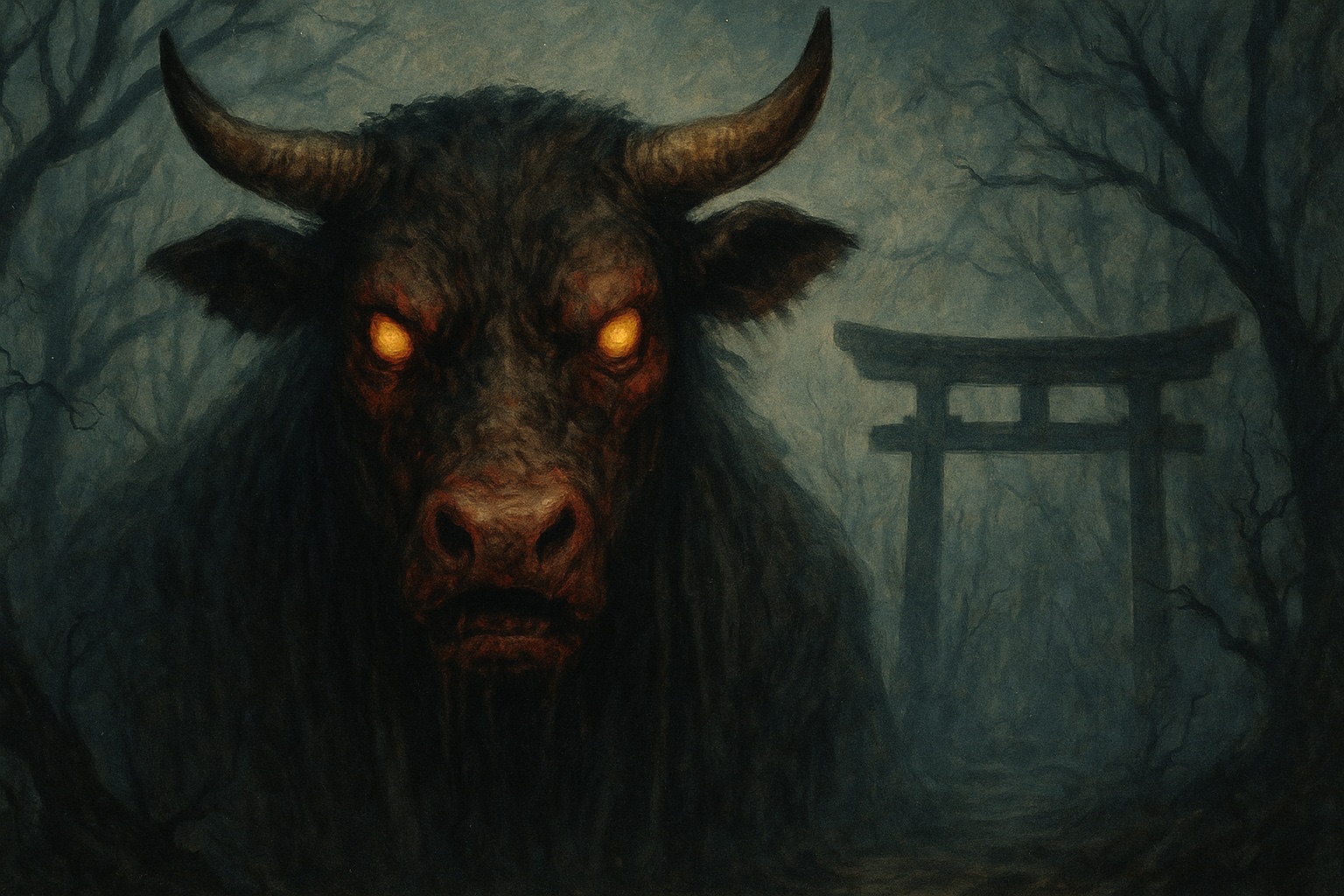
The story so terrifying, you die just from hearing it.
We begin with the ultimate meta-horror, a Japanese urban legend about a legend itself. The tale of “Gozu,” or “Cow Head,” is said to be the most frightening story ever told—so horrific that its full text has been destroyed, and only cursed fragments remain.
The most famous anecdote goes like this: A school teacher, on a bus with his students, decides to tell scary stories. He begins to narrate a tale he knows as “Cow Head.” As he speaks, the students, initially excited, become paralyzed with fear, begging him to stop. But the teacher is in a trance, unable to halt the narration. When he finally comes to his senses, the bus has crashed. The students and driver are found either foaming at the mouth in a catatonic state or dead from pure fright. None of the survivors can remember a single word of the story.
Why It’s Terrifying: The horror of Gozu lies in the unknown. By being un-tellable, it forces our own minds to conjure the most dreadful images imaginable. It’s the ultimate forbidden knowledge, a story so powerful it breaks the human psyche.
9. Kisaragi Station (The Ghost Station)

The last stop is a place that doesn’t exist.
Imagine you’re on a late-night train, the gentle rocking lulling you to sleep. But tonight, the train doesn’t stop at your station. It keeps going, deeper into the unfamiliar darkness. This is the beginning of one of the most famous internet-born Japanese urban legends: Kisaragi Station.
The story unfolded in 2004 on the Japanese forum 2channel. A user named Hasumi began posting in real-time that her train had been running for an unusually long time. It finally stopped at a station called “Kisaragi,” a name that doesn’t appear on any map. She got off, alone, onto a deserted platform. As forum users tried to help, her posts grew more frantic. She heard distant drums and eventually found a lone taxi. Her final, chilling posts described the driver taking her deeper into the mountains before she vanished forever.
Why It’s Terrifying: Kisaragi Station preys on the primal fear of being lost and disoriented. It’s a found-footage horror story in text form, a slow-burn nightmare where the environment itself is the monster. If your train ever stops at an unfamiliar station in the dead of night… stay on board.
8. Hachishaku-sama (The Eight-Foot-Tall Woman)
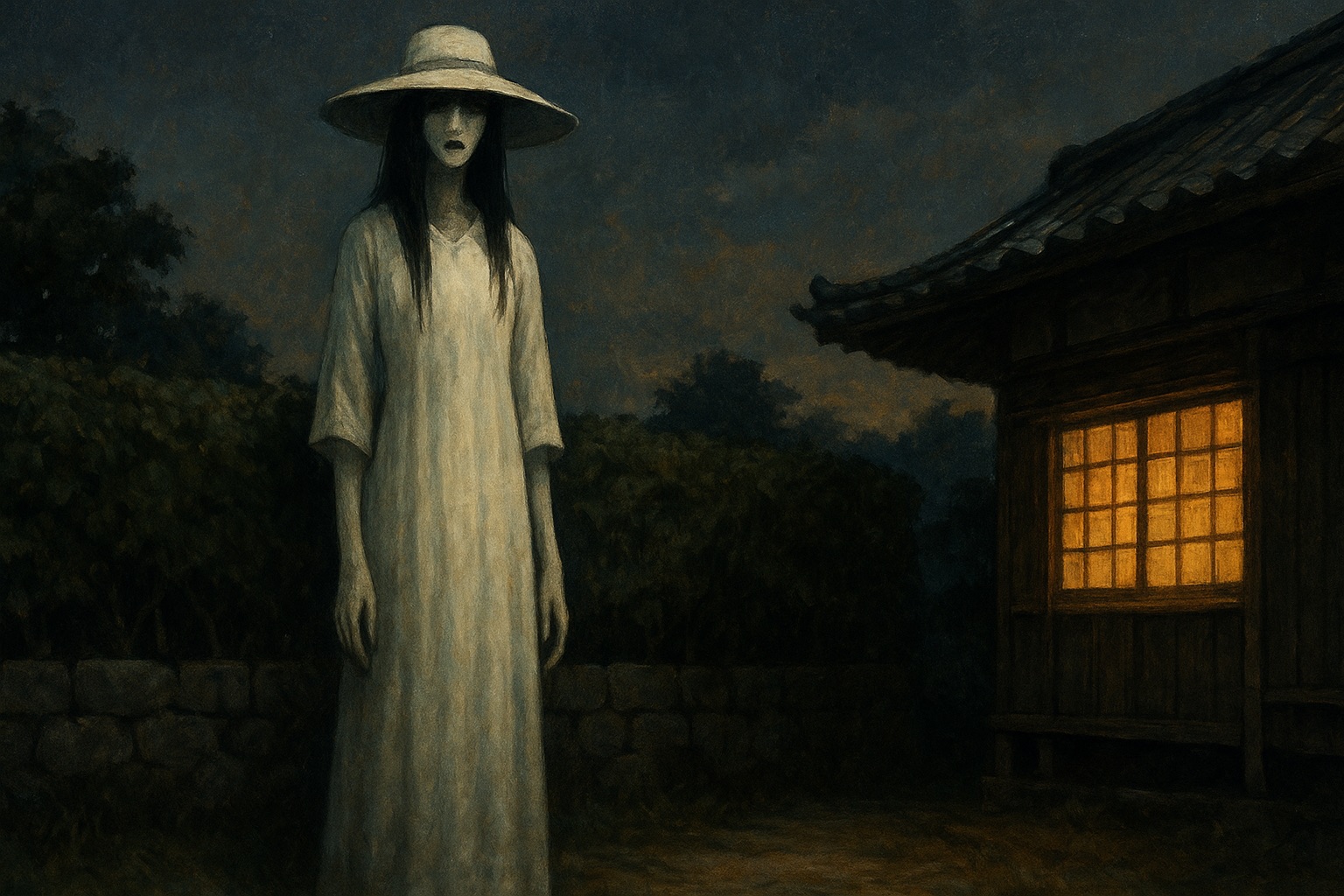
A towering specter that marks children for death.
This modern legend, born from a creepypasta, has quickly become a masterpiece. Hachishaku-sama, or the “Eight-Foot-Tall Woman,” is a monstrous entity, often appearing in a white dress and wide-brimmed hat, who emits a chilling, repetitive sound: “Po… po… po…”
The story follows a young boy who sees her peering over his grandparents’ garden hedge. His family is horrified; they know he has been “liked” by the creature. Once Hachishaku-sama chooses a victim, she relentlessly stalks them, intent on snatching them away. The family locks the boy in a room, protected by charms, warning him not to open the door for anyone. That night, he hears his grandfather’s voice pleading to be let in—a cruel trick, as she can mimic the voices of loved ones.
Why It’s Terrifying: Unlike a random haunting, Hachishaku-sama is personal. She targets you. The horror lies in the helplessness of being hunted by something so unnatural in a familiar place, turning your own backyard into a hunting ground. Her towering figure, a stark violation of human form, has drawn comparisons to Slender Man, but her distinctly Japanese, ritualistic nature makes her uniquely terrifying.
7. Inunaki Village (The Howling Village)
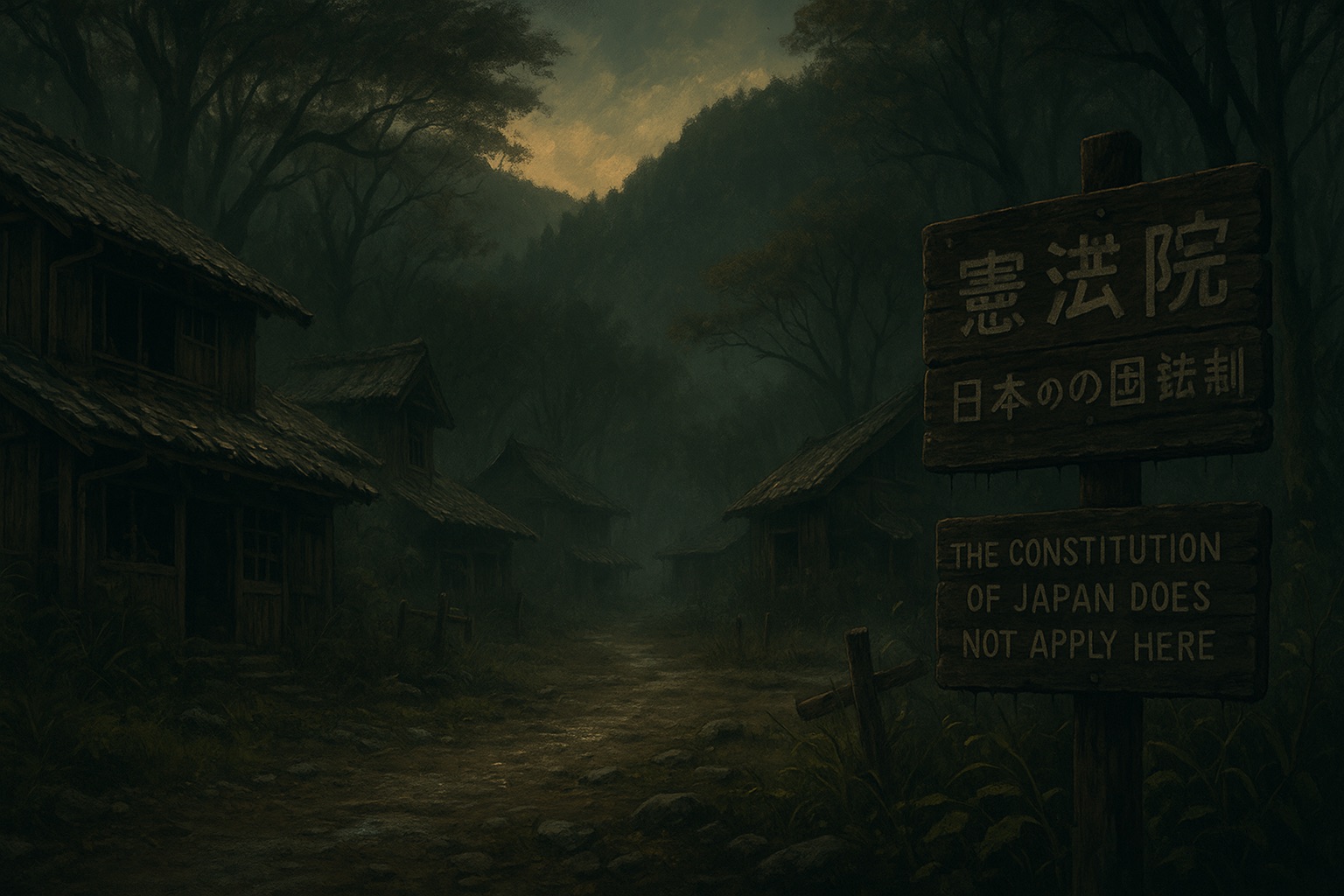
A lawless village where those who enter never leave.
Deep in the mountains of Fukuoka Prefecture lies a place where civilization ends. Inunaki Village is a legendary lost hamlet, so isolated that a battered sign at its entrance reputedly declares: “The Constitution of Japan does not apply past this point.”
According to this chilling Japanese urban legend, the village is a haven for cannibals, murderers, and inbred residents who will brutally kill any intruders. All electronic devices fail upon approach, and the air is filled with the sound of dogs howling (the meaning of “Inunaki”). The legend is purely myth, but it’s rooted in a horrific truth: the nearby Inunaki Tunnel was the site of a gruesome real-life murder in 1988, where a group of teens tortured and burned a young man alive. This brutal act likely seeded the idea that the entire area is cursed and lawless.
Why It’s Terrifying: Inunaki Village combines survival horror with folklore. The fear isn’t just of ghosts, but of humans unrestrained by law or morality. The infamous sign represents a complete loss of protection, a descent into a place where anything can happen to you, and no one will ever know.
6. The Red Room Curse (Akai Heya)
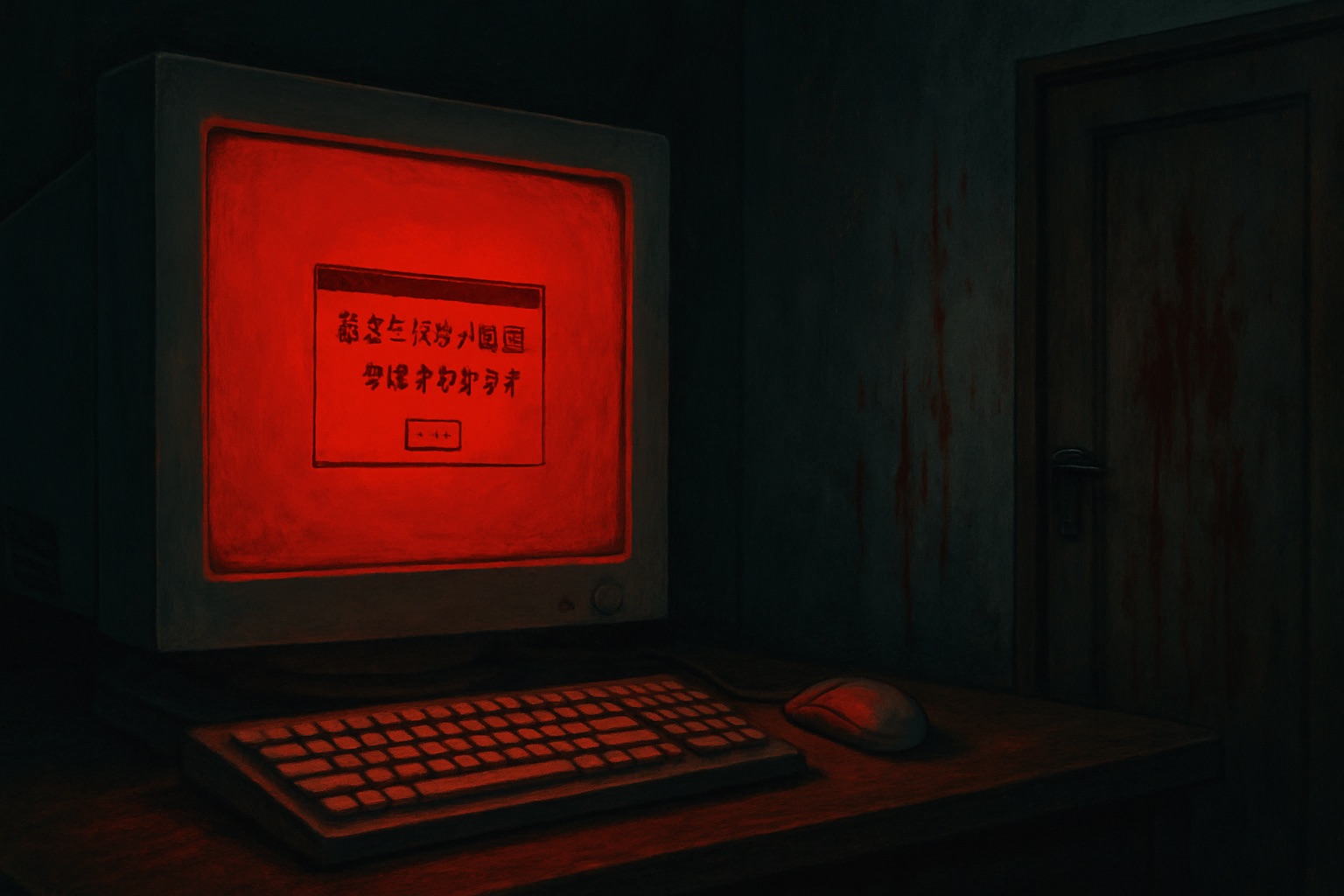
The pop-up ad that kills.
This is one of the first true internet urban legends from Japan, a story that turns a mundane annoyance into a death sentence. It starts innocently enough: a small pop-up window appears on your computer screen. It has a red background and a simple question in a synthesized, child-like voice: “Do you like the red room?”
You can’t close it. Every time you try, it reappears, the question repeating until it finally completes itself. Your screen then turns entirely red, displaying a list of names—the curse’s previous victims. The next day, you are found dead in your room, the walls painted red with your own blood. You have become the newest name on the list.
The legend gained horrifying notoriety in 2004 when it was linked to the real-life “Sasebo Slashing,” as the 11-year-old killer had the Red Room animation bookmarked on her computer.
Why It’s Terrifying: The Red Room Curse masterfully blends supernatural horror with digital anxiety. It preys on our fear of losing control over the technology we depend on and the terrifying idea that a digital threat can manifest into physical, fatal harm.
5. Tomino’s Hell (The Cursed Poem)
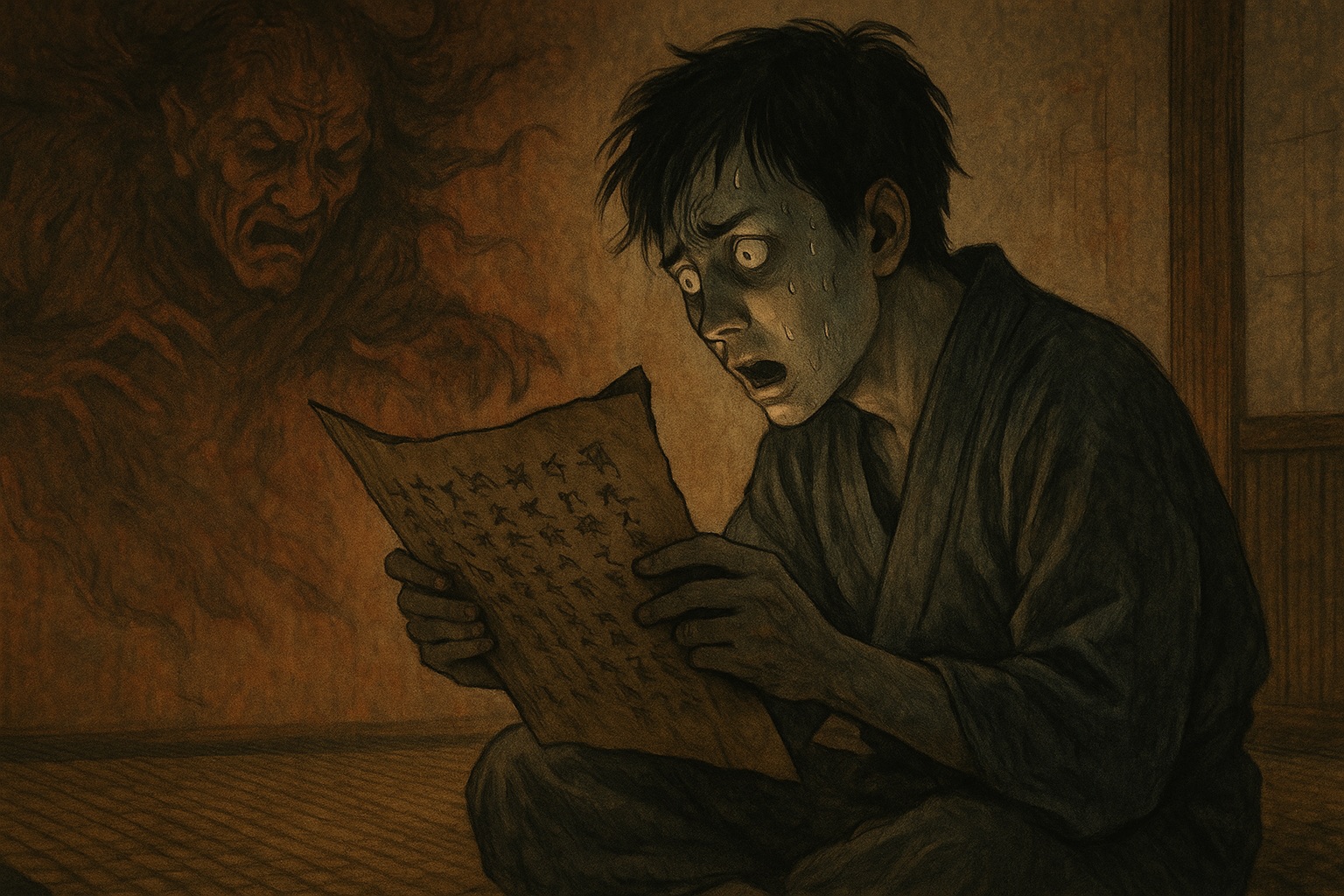
Utter these words aloud, and misfortune will find you.
Not all Japanese urban legends are about ghosts; some are about the power of words. “Tomino’s Hell” is a poem written in 1919 by Yomota Inuhiko. The poem itself is a bleak, surreal journey of a young boy descending into the lowest levels of Hell.
The legend, however, claims that to read the poem aloud is to invite disaster, illness, or even death. The curse gained widespread fame after a 2004 book warned, “If you by chance read this poem aloud, you will suffer an awful fate which you cannot escape.” People who have tried report feeling violently ill or deeply uneasy. The fear is so pervasive that online readings often use text-to-speech software to avoid speaking the words.
Why It’s Terrifying: This legend is a direct challenge to your courage. Your rational mind knows it’s just a poem. But a small, primal part of you hesitates. What if? That hesitation, the fear of unleashing a curse with your own voice, is a powerful testament to the psychological grip of these tales.
4. Hanako-san of the Toilet (Toire no Hanako-san)
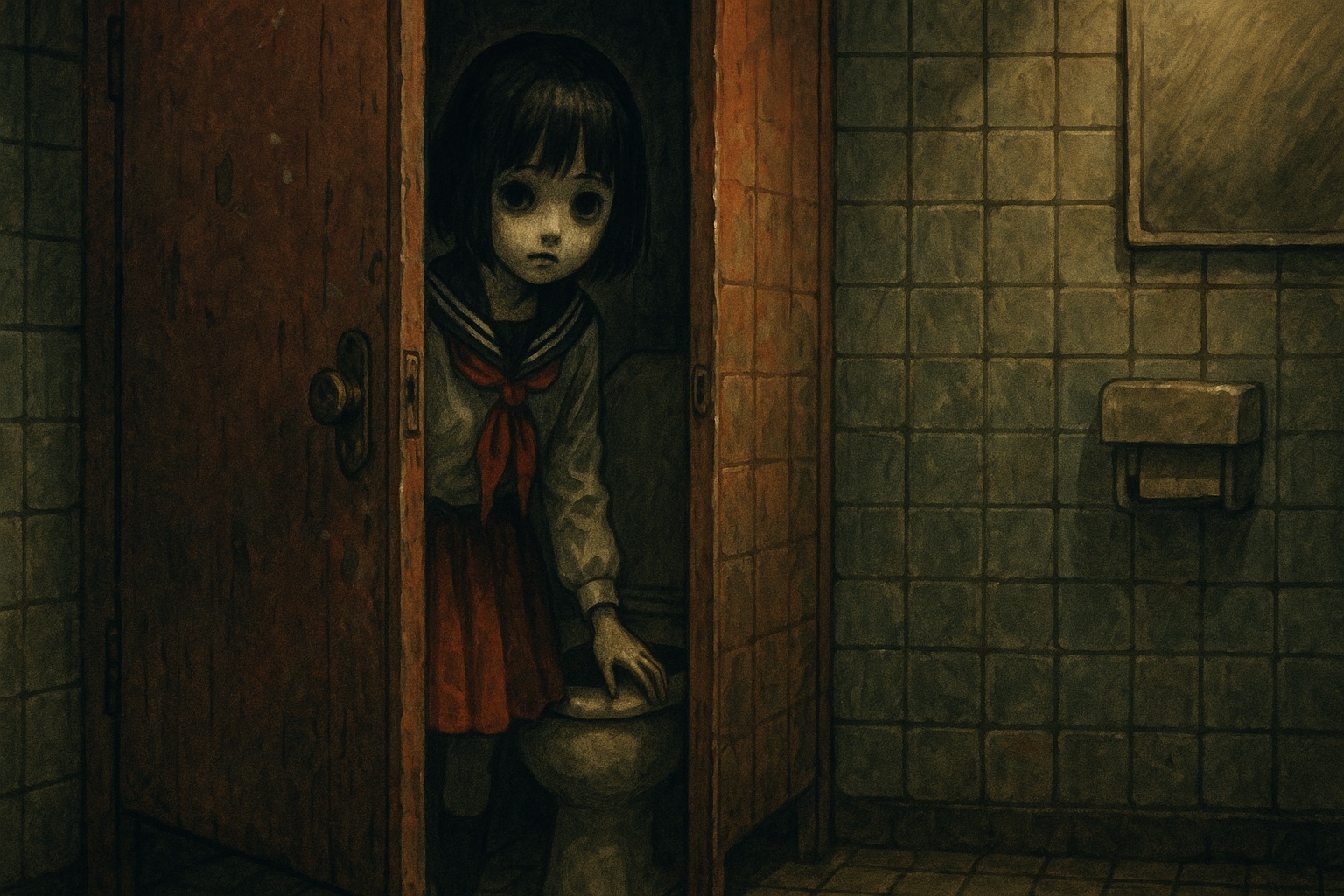
Japan’s own “Bloody Mary,” lurking in the third stall.
Every Japanese schoolchild knows the story of Hanako-san. She is the ghost of a young girl, often with a bobbed haircut and a red skirt, who haunts school bathrooms. To summon her, you must go to the third stall on the third floor, knock three times, and ask, “Hanako-san, are you there?”
If a small voice whispers, “Yes, I am,” your fate is sealed. Opening the door will reveal Hanako, who will grab you and drag you into the toilet, pulling you down to a watery hell. The origins of this legend are often tied to World War II, with Hanako being the spirit of a girl who died during an air raid while hiding in the bathroom.
Why It’s Terrifying: Hanako-san mixes childhood innocence with pure dread. It transforms a familiar, mundane place—a school bathroom—into a site of potential horror. The ritualistic summoning, much like Western legends, plays on the terrifying idea that your own actions can invite something dreadful from beyond the grave.
3. Aka Manto (The Red Cloak)
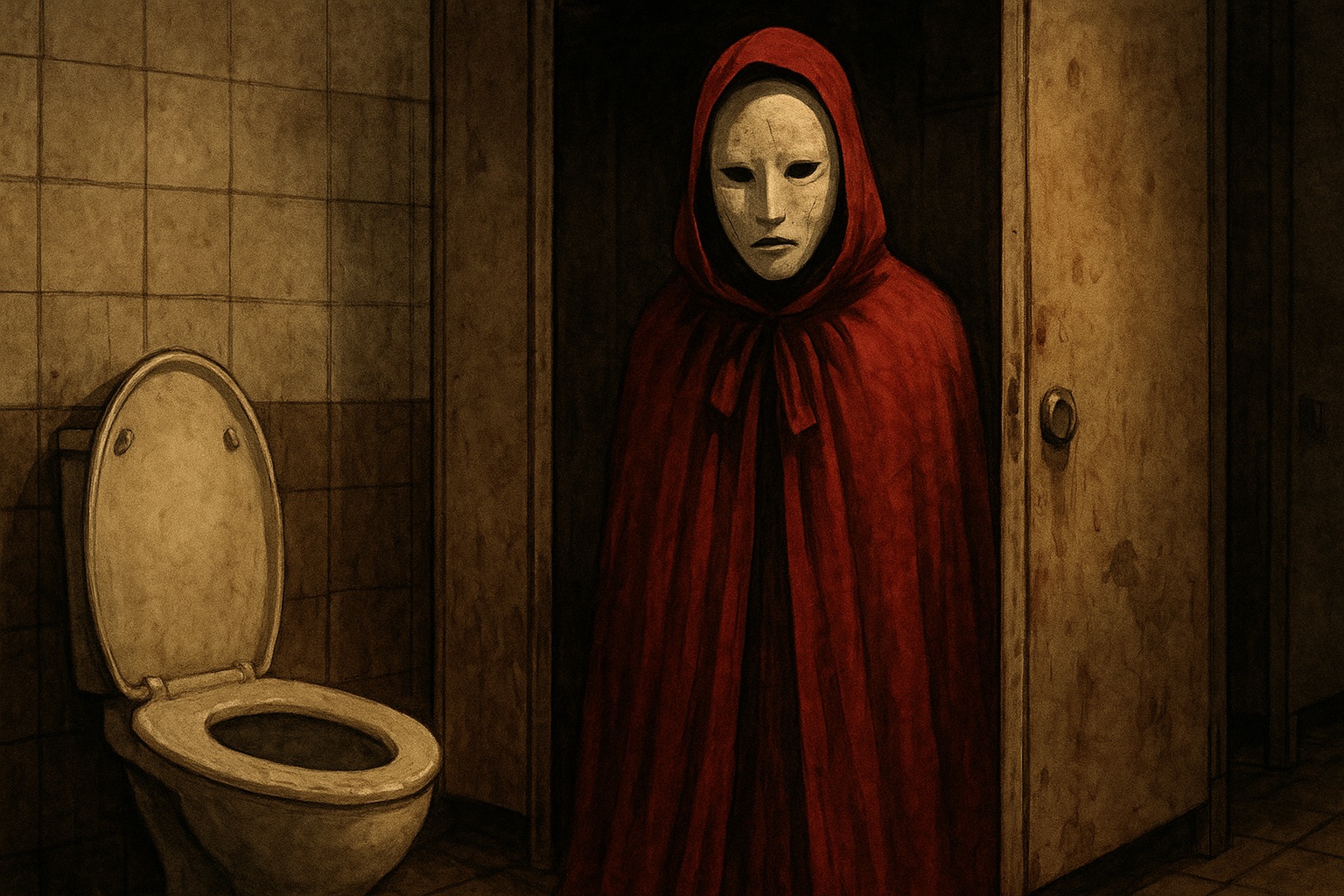
A deadly choice with no right answer.
You are at your most vulnerable, alone in a public restroom stall. Suddenly, a deep, disembodied voice from behind you asks a question: “Do you want red paper or blue paper?” This is Aka Manto, a malevolent spirit in a red cloak who presents his victims with an impossible choice.
If you choose “red,” he will violently slash you to death, covering you in your own blood.
If you choose “blue,” he will strangle you until your face turns a lifeless blue.
Trying to outsmart him by asking for another color will only result in you being dragged to the underworld. The only rumored way to survive is to refuse any paper and flee.
Why It’s Terrifying: Aka Manto represents absolute helplessness. It takes a mundane situation and turns it into a deadly trap with no escape. The horror is in the certainty of doom, where any choice you make leads directly to a gruesome end. If you hear a voice in an empty bathroom, do not answer. Just run.
2. Teke Teke
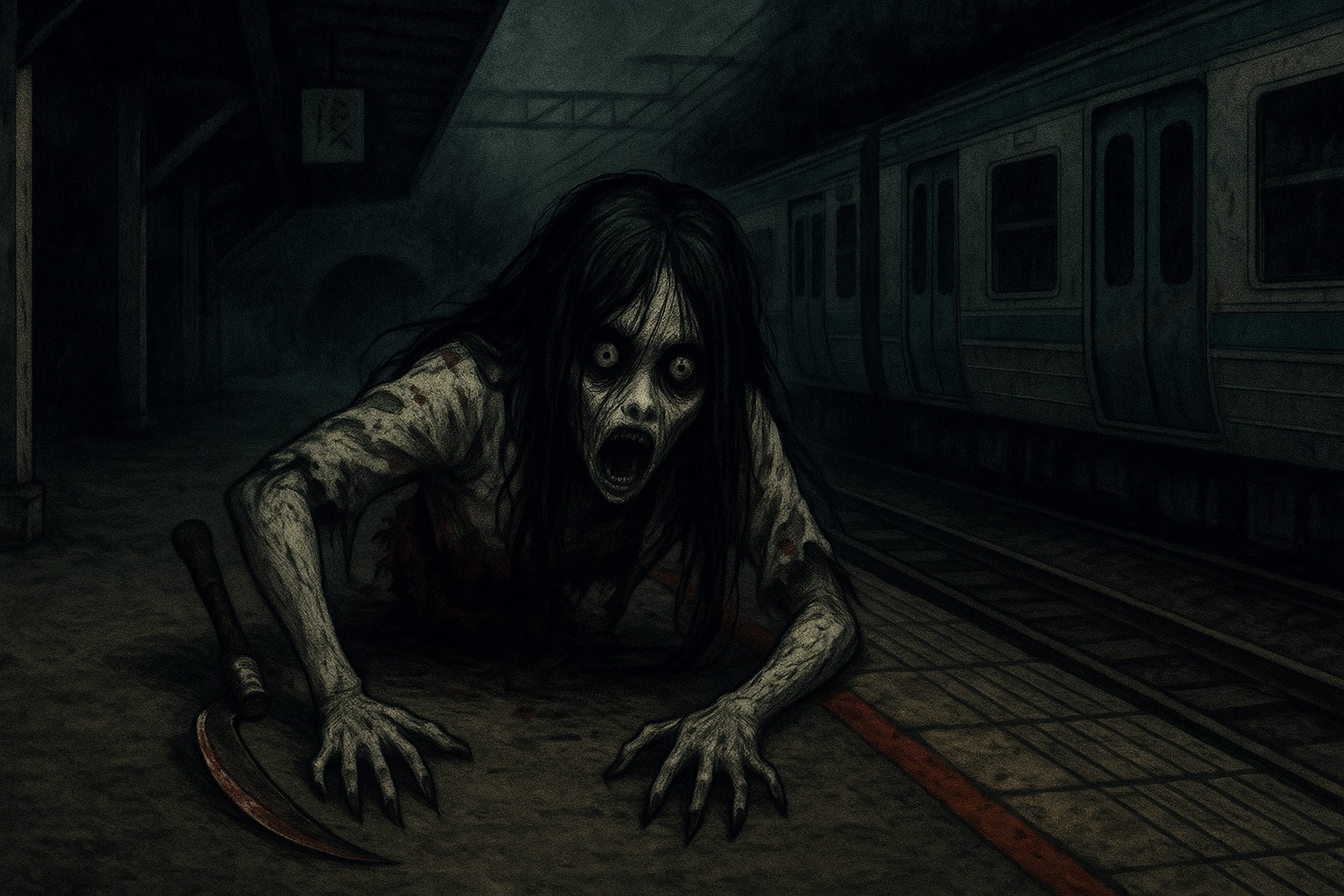
The sound of her approach is the last thing you’ll ever hear.
Hear that scratching sound? Teke… teke… teke… It’s the ghost of a young woman who was cut in half by a train. Now a vengeful spirit (onryō), she drags her upper torso along the ground with her claw-like hands, searching for victims to share her fate.
Despite having no legs, Teke Teke moves at an impossible speed, even chasing down cars. If she catches you, she will pull out a scythe and slice you in two, creating another tormented spirit just like her. Some say that hearing her story means she will appear to you within three days. Now that you’ve read this, a part of the curse is already with you.
Why It’s Terrifying: Teke Teke is a force of relentless, unnatural pursuit. The visceral horror of being chased by half a body moving at blinding speed, combined with the gruesome inevitability of her attack, makes this one of Japan’s most viscerally frightening Japanese urban legends.
1. Kuchisake-onna (The Slit-Mouthed Woman)
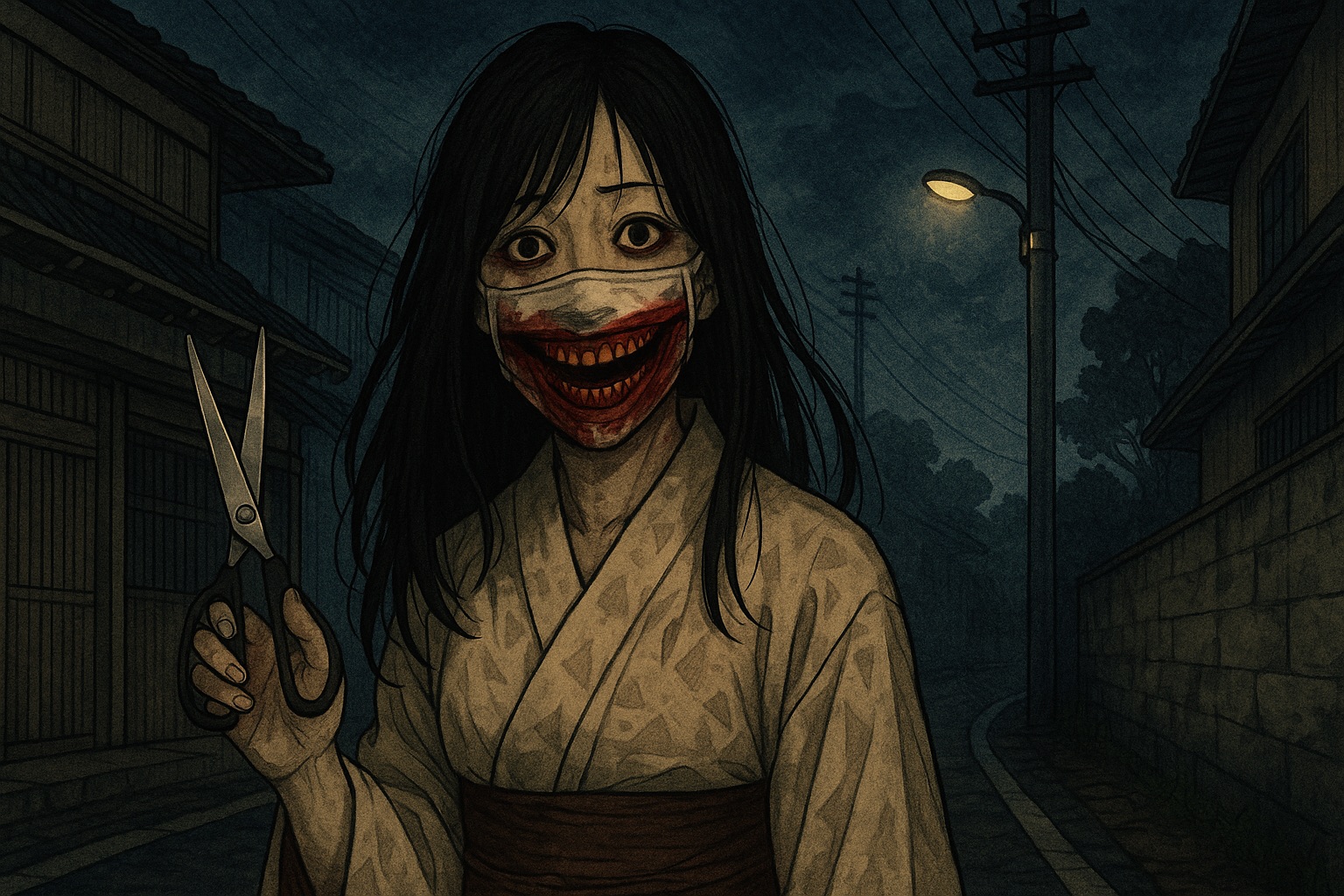
The most iconic and feared of all modern Japanese ghosts.
She appears before you on a lonely street at night, a beautiful woman whose lower face is obscured by a surgical mask—a common sight in Japan. She stops you and asks a simple, chilling question: “Am I pretty?”
How you answer determines your fate.
If you say “No,” she kills you instantly.
If you say “Yes,” she removes her mask to reveal a mouth slit horribly from ear to ear. “How about now?” she asks. Any answer at this point—or screaming, or running—will result in her using a pair of scissors to cut your own mouth into a gruesome, matching smile.
This legend is so powerful that in 1979, reports of a real-life Kuchisake-onna caused a nationwide panic in Japan, with police increasing patrols and schools escorting children home.
Why It’s Terrifying: Kuchisake-onna is the ultimate urban legend because of her terrifying plausibility. She could be anyone. A simple, polite encounter on a dark street could turn into a bloody, inescapable end. She is the terrifying proof that in the world of Japanese urban legends, the most horrifying monsters wear human faces.
Sweet Dreams…
From vengeful spirits to digital curses, the urban legends of Japan prove that the fear of the unknown is a universal language, constantly evolving to haunt our modern world. These tales linger long after you’ve turned off the lights, a chilling reminder of the darkness that may lurk just out of sight.
Think about the stories you’ve just read. Which one burrowed deepest into your mind? Which shadow will you see in the corner of your eye tonight?
Of course, you can tell yourself they’re all just stories. But as one Japanese saying goes, “If you believe in ghosts, you’ll be haunted by them.”
※ Unauthorized reproduction, video creation, and uploading of this article's content to YouTube, blogs, or other platforms is strictly prohibited.
Related Articles

Jinmenken: The Definitive Guide to Japan’s Eerie Human-Faced Dog

Hanako-san: The Terrifying Legend of the Japanese Ghost in the Bathroom Stall

Kuchisake-Onna: The Definitive Guide to Japan’s Terrifying Slit-Mouthed Woman

Tsuchinoko: The Definitive Guide to Japan’s Legendary Snake Monster and its $1 Million Bounty
Popular Series
This is the page for 10 Terrifying Japanese Urban Legends That Will Chill You to the Bone. Find the latest news about JapaneseHorror, Folklore and more on TOCANA - the paranormal news media that stimulates your curiosity
Urban Legends Latest Articles
The Definitive Guide to Japan's Scariest Urban Legends: From Kuchisake-Onna to Kisaragi Station
2025.10.20 23:00 Urban LegendsKunekune: The Definitive Guide to Japan's Terrifying, Twisting Field Monster
2025.10.19 23:00 Urban LegendsNNN Special Broadcast: The Definitive Guide to Japan's Lost, Lethal TV Broadcast
2025.10.14 23:00 Urban Legends